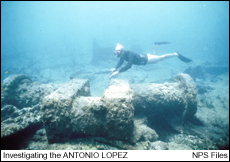|
List Of U.S. National Historic Landmark Ships And Shipwrecks
This is a list of the 133 National Historic Landmarks in the United States that are ships, shipwrecks, or shipyards.The United States Naval Academy, in Maryland, is a ship-related institution that is also an NHL, but is not included in the count of 133. The list of 133 is based on review of the "National Historic Landmarks Survey: List of National Historic Landmarks by State" document and searching on related National Park Service websites. Of the more than 2,500 NHLs, about 5 percent are ships, shipwrecks, or shipyards. The NHL ships, shipwrecks, and shipyards are distributed across 31 states, the District of Columbia, Puerto Rico, and the U.S.-associated state of Micronesia. Nineteen states have no ships among their NHLs. Shipwrecks Ships States having no ships among their NHLs are: Arizona, Colorado, Delaware, Georgia, Idaho, Kansas, Minnesota, Montana, Nevada, New Jersey, New Mexico, North Dakota, Oklahoma, Rhode Island, South Dakota, Tennessee, Utah, West Virginia, and ... [...More Info...] [...Related Items...] OR: [Wikipedia] [Google] [Baidu] |
National Historic Landmark
A National Historic Landmark (NHL) is a building, district, object, site, or structure that is officially recognized by the United States government for its outstanding historical significance. Only some 2,500 (~3%) of over 90,000 places listed on the country's National Register of Historic Places are recognized as National Historic Landmarks. A National Historic Landmark District may include contributing properties that are buildings, structures, sites or objects, and it may include non-contributing properties. Contributing properties may or may not also be separately listed. Creation of the program Prior to 1935, efforts to preserve cultural heritage of national importance were made by piecemeal efforts of the United States Congress. In 1935, Congress passed the Historic Sites Act, which authorized the Interior Secretary authority to formally record and organize historic properties, and to designate properties as having "national historical significance", and gave the Nation ... [...More Info...] [...Related Items...] OR: [Wikipedia] [Google] [Baidu] |
Tugboat Arthur Foss 04
A tugboat or tug is a marine vessel that manoeuvres other vessels by pushing or pulling them, with direct contact or a tow line. These boats typically tug ships in circumstances where they cannot or should not move under their own power, such as in crowded harbour or narrow canals, or cannot move at all, such as barges, disabled ships, log rafts, or oil platforms. Some are ocean-going, some are icebreakers or salvage tugs. Early models were powered by steam engines, long ago superseded by diesel engines. Many have deluge gun water jets, which help in firefighting, especially in harbours. Types Seagoing Seagoing tugs (deep-sea tugs or ocean tugboats) fall into four basic categories: #The standard seagoing tug with model bow that tows almost exclusively by way of a wire cable. In some rare cases, such as some USN fleet tugs, a synthetic rope hawser may be used for the tow in the belief that the line can be pulled aboard a disabled ship by the crew owing to its lightness com ... [...More Info...] [...Related Items...] OR: [Wikipedia] [Google] [Baidu] |
Arthur Foss (tugboat)
''Arthur Foss'', built in 1889 as ''Wallowa'' at Portland, Oregon, is likely the oldest wooden tugboat afloat in the world. Its 79-year commercial service life began with towing sailing ships over the Columbia Bar, Columbia River bar, and ended with hauling bundled log rafts on the Strait of Juan de Fuca in 1968. Northwest Seaport now preserves the tug as a museum ship in Seattle, Washington (state), Washington. The tug's long service in the Pacific Northwest, including a role in the Klondike Gold Rush, was interrupted by preparations for war in early 1941. After delivering a drydock gate to Pearl Harbor the tug was chartered by Contractors Pacific Naval Air Bases, a consortium formed to build air fields on remote Pacific islands as the United States prepared for war. In June 1941 ''Arthur Foss'' was supporting construction on Wake Island and was there in November along with the smaller ''Justine Foss'' transporting construction materials from barges in the lagoon to the island. ... [...More Info...] [...Related Items...] OR: [Wikipedia] [Google] [Baidu] |


